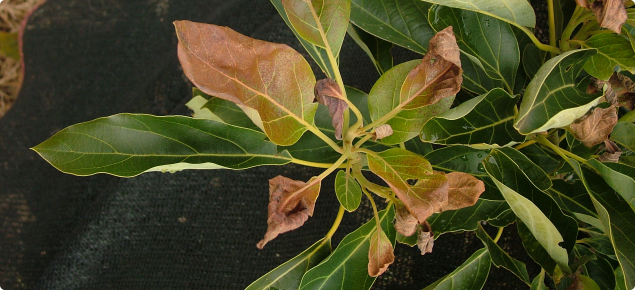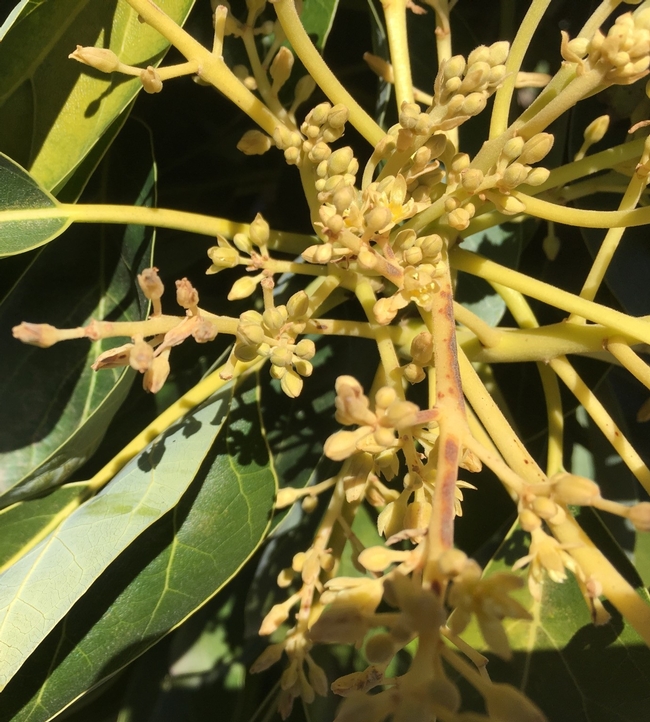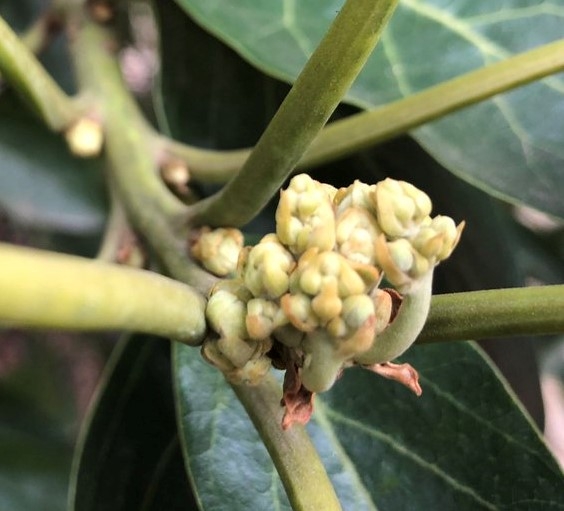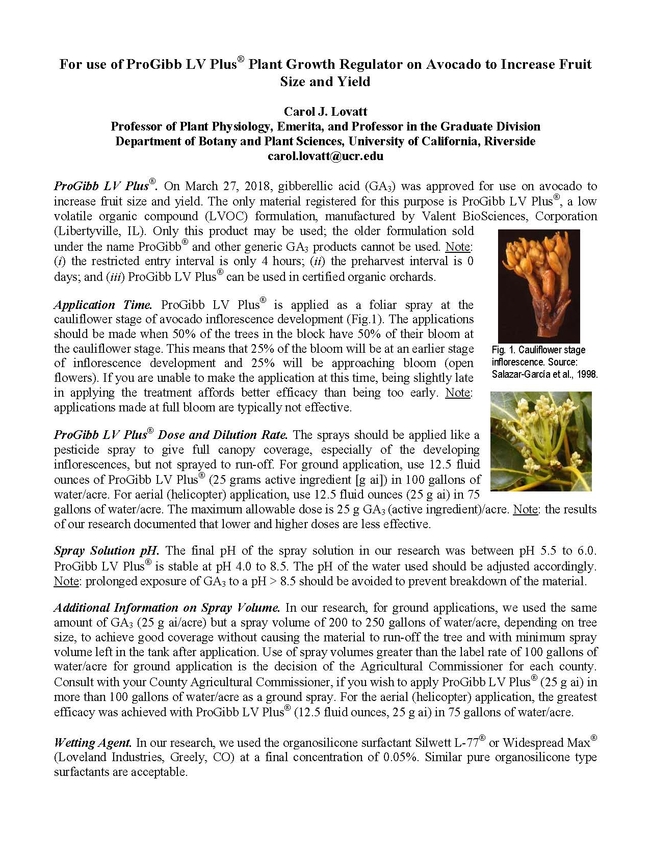
Posts Tagged: acid
Time to Gibb Avocados?
Avocados in some parts of coastal California have been blooming. Some of them got hit by the cold weather in the first part of February. In the coldest areas there was a little bit of new leaf damage, but this has been minimal.
Some browning of some flowers and stems (pedicels - the little stalks the connect the flowers to the larger raceme/panicle) may have occurred, but I haven't heard of major flower damage.
It's early days for flowering, though, and most ‘Hass' trees are not very far along, but seem like they area about to burst. A recent visit on a 40 acre farm in Saticoy had trees in a whole range of stages, some with no flowers pushing, some with panicles just starting to open individual flowers and many trees on their north sides' completely quiet. Many are still just pushing into the cauliflower stage,
which is the ideal time is for applying Pro-Gibb to improve fruit set in healthy orchards.
Application time is when 50% of the trees in the block have 50% of their bloom in the cauliflower stage. This is a judgment call when there can be such huge variation in bloom across and orchard. It's going to be a best estimate call for when to do the application. As usual with a new technology/practice don't apply to the whole orchard so that you can see whether the application is warranted.
For a more detailed discussion of gibb application, read Carol Lovatt's article:

avocado flowers 2
Controlling Soil pH with a Grass?
This is an intriguing article that popped up about how to improve blueberry production in alkaline soils. High pH soils are a major issues for many of our tree crops along the coast. pH is what controls the availability of most plant nutrients and what bacteria and fungi grow in the soil, creating the biosphere. So can growing a grass cover crop in our orchards improve lemon and avocado production?
A lawn is better than fertilizer growing healthy blueberries
Intercropping with grasses is an effective and sustainable alternative to chemical treatments for maximizing blueberry yield and antioxidant content in limey soils.
Blueberries are prone to iron deficiency - and correcting it increases their health-enhancing antioxidant content, researchers have discovered.
Published in Frontiers in Plant Science, their study shows that growing grasses alongside blueberry plants corrects signs of iron deficiency, with associated improvements in berry quantity and quality. The effects are comparable to those seen following standard chemical treatment - providing a simpler, safer, cheaper and more sustainable strategy for blueberry farming on sub-optimal soils.
What do superfruits eat?
All soils are rich in iron, but nearly all of it is insoluble.
"Most plants get enough iron by secreting chemicals that make it more soluble," explains senior study author Dr José Covarrubias, Assistant Professor of Agriculture Sciences at the University of Chile. "These iron 'chelators' can be released directly from the roots, or from microbes that grow among them, and allow the iron to be absorbed."
"Blueberries, however, lack these adaptations because they evolved in uncommonly wet, acid conditions which dissolve the iron for them."
As a result, most of the world's relatively dry or alkaline ('limey') cropland is unsuitable for optimal blueberry growth.
"Iron is essential for the formation and function of plant molecules like chlorophyll that allow them to use energy," Covarrubias continues. "That's why iron deficiency shows up as yellowing leaves - and drastically reduces plant growth and yield.
"And in blueberries, iron-dependent enzymes also produce the 'superfruit' antioxidants responsible for their celebrated blue skin and health-enhancing effects."
Strong blueberries must pump iron - but at what cost?
There are two approaches to correcting iron deficiency in blueberries: acidify the soil, or add synthetic iron chelators. Each has its drawbacks, says Covarrubias.
"The commonest industrial approach is soil acidification using sulfur, which is gradually converted by soil bacteria into sulfuric acid. The effects are slow and difficult to adjust - and in waterlogged soils, hydrogen sulfide might accumulate and inhibit root growth.
"Acids can also be added directly via irrigation systems for more rapid acidification - but these are hazardous to farmers, kill beneficial soil microbes, and generate carbon dioxide emissions.
"A commoner strategy among growers is application of iron bound to synthetic chelators - often sold as 'ericaceous fertilizer' - but these are very expensive and leach potentially toxic chemicals into the water table."
A cheaper, safer alternative is needed for efficient large-scale blueberry production. Thankfully, one already exists.
"Grasses - which are well-adapted to poor soils - can provide a sustainable, natural source of iron chelators via their roots when grown alongside fruiting plants. Intercropping with grass species has been shown to improve plant growth and fruit yield in olives, grapes, citrus varieties - and most recently, in blueberries."
A grassroots approach to sustainable blueberry farming
Now, Covarrubias and colleagues have brought intercropping a step closer to the mainstream of blueberry cultivation.
For the first time, they measured the effects of different methods of iron chelation on antioxidant content and other fruit qualities in blueberries.
"In an orchard of 'Emerald' blueberry bushes cultivated in alkaline (pH 8) soil, we compared the effects of five different iron chelation treatments: a 'gold-standard' synthetic iron chelator (Fe-EDDHA), intercropping with grass (common meadow grass or red fescue), cow's blood (Fe-heme), or no treatment (control)."
"We found the association with grasses increased not only the total weight and number of blueberries per plant, but also the concentration of anthocyanins and other antioxidant compounds in their skins, compared to control. The effect sizes were comparable with the proven synthetic chelator Fe-EDDHA, whereas applications of Fe-heme from cow's blood - a fertilizer commonly used in home gardens - had no significant effect."
The beneficial effects paralleled improvement in the plants' iron status (leaf color), which was also comparable between the grass-associated and the Fe-EDDHA-treated plants. None of the treatments had a significant effect on average berry weight
Turf is ready to roll out for healthier blueberries
A potential limitation of intercropping observed in the study was a decrease in berry firmness, since firmer berries are favored by consumers.
"The association with grasses decreased berry firmness compared with control plants, whereas the berries collected from plants treated with Fe-EDDHA reached intermediate values.
"However chemical analysis showed a non-significant trend towards increased ripeness in the berries collected from the intercropped plants, which could account for this small difference."
Intercropped plants also required an additional water supply to maintain a similar soil moisture to other treatments, but plant management was otherwise straightforward and the same across groups. The grasses were kept cropped between 5 and 15cm - a typical range for an attractive mown lawn.
"Our findings validate intercropping with grasses as a simple, effective, sustainable alternative to standard iron correction strategies in blueberries," concludes Covarrubias. "Both commercial and private growers can put this strategy to use right away to boost their blueberry crop and antioxidant content."
###
Please link to the original research article in your reporting: https://www.frontiersin.org/articles/10.3389/fpls.2019.00255/full
Frontiers is an award-winning Open Science platform and leading Open Access scholarly publisher. Our mission is to make research results openly available to the world, thereby accelerating scientific and technological innovation, societal progress and economic growth. We empower scientists with innovative Open Science solutions that radically improve how science is published, evaluated and disseminated to researchers, innovators and the public. Access to research results and data is open, free and customized through Internet Technology, thereby enabling rapid solutions to the critical challenges we face as humanity. For more information, visit http://www.frontiersin.org and follow @FrontiersIn on Twitter.

soil colors
Frosted Flowers? Still Time to Gibb
Avocados in some parts of coastal California have been blooming. Some of them got hit by the cold weather in the first part of February. In the coldest areas there was a little bit of new leaf damage, but this has been minimal.
Some browning of some flowers and stems (pedicels - the little stalks the connect the flowers to the larger raceme/panicle) may have occurred, but I haven't heard of major flower damage.
It's early days for flowering, though, and most ‘Hass' trees are not very far along, but seem like they area about to burst. A recent visit on a 40 acre farm in Saticoy had trees in a whole range of stages, some with no flowers pushing, some with panicles just starting to open individual flowers and many trees on their north sides' completely quiet. Many are still just pushing into the cauliflower stage,
which is the ideal time is for applying Pro-Gibb to improve fruit set in healthy orchards.
Application time is when 50% of the trees in the block have 50% of their bloom in the cauliflower stage. This is a judgment call when there can be such huge variation in bloom across and orchard. It's going to be a best estimate call for when to do the application. As usual with a new technology/practice don't apply to the whole orchard so that you can see whether the application is warranted.
For a more detailed discussion of gibb application, read Carol Lovatt's article:
Mulch and Avocado Root Rot and Gibberellic Acid Too!
Upcoming CAS/UC/CAC Seminar Addresses
Mulch,
Phytophthora and
Gibberellic Acid Use
The California Avocado Society will host the first of its 2019 California Avocado Growers Seminar Series with workshops focused on mulch and Phytophthora. Dr. Ben Faber, Dr. Tim Spann and Dr. Carol Lovatt will deliver presentations at the seminars.
Dr. Ben Faber, UC Cooperative Extension Soils/Water/Subtropical Crops Farm Advisor, will speak about the benefits of using mulch in avocado groves. Ben will discuss the various types of mulch that can be used, how and when to apply them and the benefits of using mulch in avocado groves.
Dr. Tim Spann, California Avocado Commission Research Program Director, will cover Phytophthora 101. Tim will discuss what phytophthora species affect avocados, how to recognize symptoms of phytophthora infection in avocados and best management practices for dealing with phytophthora.
Dr. Carol Lovatt, UC Riverside Emeritus Professor of Plant Physiology, will discuss the use of gibberellic acid (GA) plant growth regulator on avocados. A special local needs registration was obtained in early 2018 for use of GA on avocado in California. Carol will discuss the benefits of using GA, and when and how to apply it for those growers interested in trying this new tool.
The seminars will be held as follows:
Tuesday, February 5, 1:00 p.m. – 3:00 p.m.
SLO Farm Bureau, 4875 Morabito Place, San Luis Obispo, CA 93401
Wednesday, February 6, 9:00 a.m. – 11:00 a.m.
UC Cooperative Extension Office Auditorium, 669 County Square Drive, Ventura, CA 93003
Thursday, February 7, 12: 30 p.m. – 2:30 p.m.
Fallbrook Public Utility District Board Room, 990 East Mission Road, Fallbrook, CA 92028
And read more about Mulch Myths:
https://ucanr.edu/blogs/blogcore/postdetail.cfm?postnum=28917
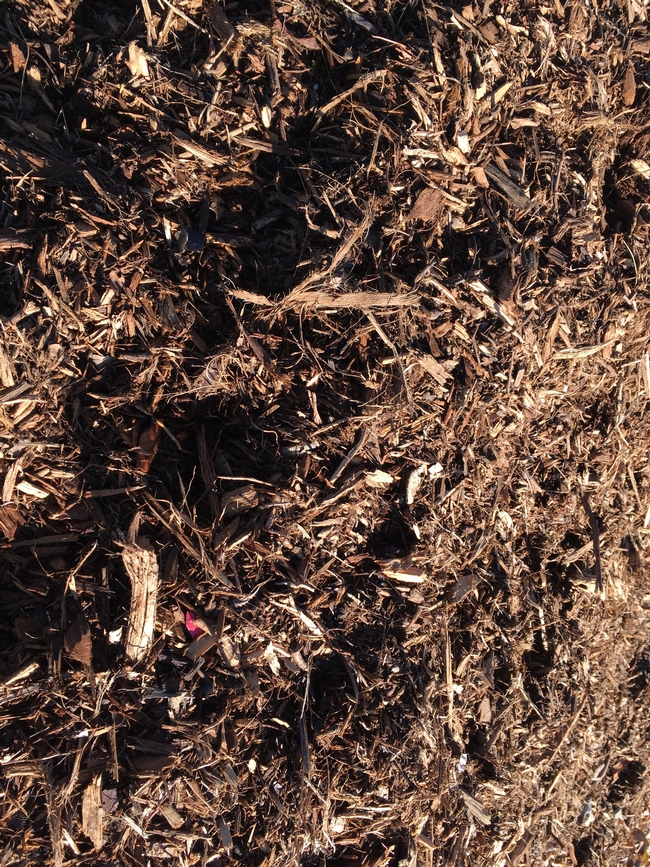
euc and a bit of scrap
Make More Avocado Fruit
At a recent grower meeting at South Coast Research and Extension Center in Irvine, Carol Lovatt gave a talk on the use of gibberellic acid to increase avocado fruit set and yield. The registration for the use only occurred this spring, barely in time for growers to use it, so not many applied it. Then we had this heat wave in July and a lot of fruit, whether it had been treated or not, fell off. A show of hands was asked of the growers present, who had applied it this spring. Of the 100 people or so in attendance, only five raised their hands. Of course, this is not a scientific survey, but most would try it again this coming spring, even though they might not have seen results this year.
The following are guidelines that were provided on how to use it, if you should so choose this coming spring:
Use of ProGibb LV PlusR Plant Growth Regulator on Avocado to Increase Fruit Size and Yield
Carol Lovatt
Professor of Plant Physiology, Emerita, and Professor in the Graduate Division, Department of Botany and Plant Sciences, University of California, Riverside carol.lovatt@ucr.edu
ProGibb LV PlusR. On March 27, 2018, gibberellic acid (GA3) was approved for use on avocado to increase fruit size and yield. The only material registered for this purpose is ProGibb LV PlusR, a low volatile organic compound (LVOC) formulation, manufactured by Valent BioSciences, Corporation (Libertyville, IL). Only this product may be used; the older formulation sold under the name ProGibbR and other generic GA3 products cannot be used. Note: (i)the restricted entry interval is only 4 hours; (ii) the preharvest interval is 0 days; and (iii) ProGibb LV PlusÒ can be used in certified organic orchards.
Application Time. ProGibb LV PlusR is applied as a foliar spray at the cauliflower stage of avocado inflorescence development. The applications should be made when 50% of the trees in the block have 50% of their bloom at the cauliflower stage. This means that 25% of the bloom will be at an earlier stage of inflorescence development and 25% will be approaching bloom (open flowers). If you are unable to make the application at this time, being slightly late in applying the treatment affords better efficacy than being too early. Note: applications made at full bloom are typically not effective.
ProGibb LV PlusR Dose and Dilution Rate. The sprays should be applied like a pesticide spray to give full canopy coverage, especially of the developing inflorescences, but not sprayed to run-off. For ground application, use 12.5 fluid ounces of ProGibb LV PlusR (25 grams active ingredient [g ai]) in 100 gallons of water/acre. For aerial (helicopter) application, use 12.5 fluid ounces (25 g ai) in 75 gallons of water /acre. The maximum allowable dose is 25 g GA3 (active ingredient)/acre. Note: the results of our research documented that lower and higher doses are less effective.
Spray Solution pH. The final pH of the spray solution in our research was between pH 5.5 to 6.0. ProGibb LV PlusR is stable at pH 4.0 to 8.5. The pH of the water used should be adjusted accordingly. Note: prolonged exposure of GA3 to a pH > 8.5 should be avoided to prevent breakdown of the material.
Additional Information on Spray Volume. In our research, for ground applications, we used the same amount of GA3 (25 g ai/acre) but a spray volume of 200 to 250 gallons of water/acre, depending on tree size, to achieve good coverage without causing the material to run-off the tree and with minimum spray volume left in the tank after application. Use of spray volumes greater than label rate of 100 gallons of water/acre for ground application is the decision of the Agricultural Commissioner for each county. Consult with your County Agricultural Commissioner, if you wish to apply ProGibb LV PlusR (25 g ai) in more than 100 gallons of water/acre as a ground spray. For the aerial (helicopter) application, the greatest efficacy was achieved with ProGibb LV PlusR (12.5 fluid ounces, 25 g ai) in 75 gallons of water/ acre.
Wetting Agent. In our research, we used the organosilicone surfactant Silwett L-77R or Widespread MaxR (Loveland Industries, Greely, CO) at a final concentration of 0.05%. Similar pure organosilicone type surfactants are acceptable.
Photo: Cauliflower stage inflorescence. Source: Salazar-García et al., 1998.
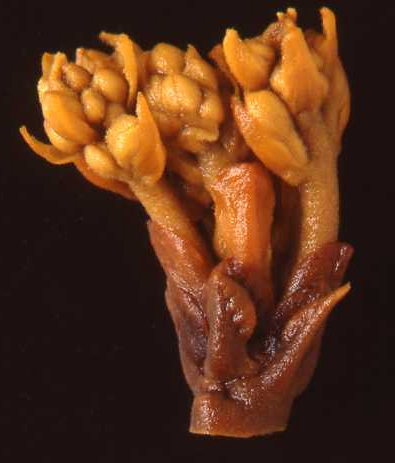
avocado cauliflower stage

